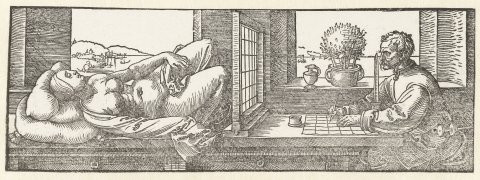The intersector is a rectangular frame stretched over a very fine, squared canvas that the draftsman places between himself and his model, then transfers square by square what he distinguishes through it. In his treatise De la peinture (1435), Alberti claimed its invention and recommended its use, which marked the beginning of the generalization of linear perspective, the break with medieval modes of representation and organization of space, and the beginning of the Renaissance in drawing and painting:
"We must thus apply ourselves to this tracing of contours, and to obtain it perfectly, I believe we can find nothing more practical than this veil that I'm in the habit of calling with my friends intersector and whose use I first invented. It's made in this way: it's a veil of very fine thread, loosely woven, dyed any color, divided by means of thicker threads into as many strips of squares as you like, and stretched over a frame. I place it between the body to be represented and the eye, so that the visual pyramid penetrates through the days of the veil. This intersection of the veil offers many advantages, firstly because it always presents the same immobile surfaces, since once you've placed your marks, you immediately find the same point of the pyramid as before, which is very difficult to achieve without the intersector." (Alberti, De Pictura, II, ed. Macula, p. 147.)
The pyramid alluded to in this text is the famous visual pyramid theorized by Alberti, whose apex is the vanishing point in a painting depicted according to the rules of linear perspective. Nearly a century later, Dürer would also propose a treatise on perspective, making extensive use of the intersectoral, which is now a glass plate. The interest of Dürer's treatise lies in the 19 woodcuts it contains, and in particular the three engravings in which the artist is depicted using this instrument. See Albrecht Dürer, Instructions concerning the manner of drawing and the use of the compass, Nuremberg, 1525, in-fol.

The intersector is certainly a simple technical tool, a practical, empirical method for drawing in perspective. It is nonetheless fraught with symbolic implications. On the one hand, by instituting for the painter a practice of the crossed-out gaze (the artist doesn't look directly at his object, but looks at it through the intersector), it prepares the constitution of the scenic break-in device, which reverberates this technical transformation on the semiological (screen of representation) and thematic (voyeurism) levels. On the other hand, by veiling the object, we return to the medieval theology of images, for which the image is viewed and consumed only after the transgression of the second commandment ("Thou shalt not make an image") has been justified. So, in a way, the image is only looked at "just the same". For the medieval Christian, entering the image meant entering the tabernacle, passing from the Holy to the Holy of Holies, crossing the veil that separated the public space (the Holy) from the space reserved for priests (the Holy of Holies). This crossing was authorized by God himself at Christ's incarnation (God then made an image) and every time grace is given to the Christian (metaphorically, grace tears the veil of the Holy of Holies).
It's no coincidence, then, that Alberti first calls his intersector "veil": by interposing a veil between the painter and the image, he adopts the posture permitted by the Church for the Christian. But in so doing, he radically secularizes the veil and initiates the semiological revolution of the Renaissance.
Critique et théorie
Archive mise à jour depuis 2008
Critique et théorie
Généalogie médiévale des dispositifs
Entre économie et mimésis, l’allégorie du tabernacle
Trois gouttes de sang sur la neige
Iconologie de la fable mystique
La polémique comme monde
Construire Sénèque
Sémiologie classique
De la vie à l’instant
D'un long silence… Cicéron dans la querelle française des inversions (1667-1751)
La scène et le spectre
Dispositifs contemporains
Résistances de l’écran : Derrida avec Mallarmé
La Guerre des mondes, la rencontre impossible
Dispositifs de récit dans Angélique de Robbe-Grillet
Disposition des lieux, déconstruction des visibilités
Physique de la fiction
Critique de l’antimodernité
Mad men, Les Noces de Figaro
Le champ littéraire face à la globalisation de la fiction
Théorie des dispositifs
Image et subversion. Introduction
Image et subversion. Chapitre 4. Les choses et les objets
Image et subversion. Chapitre 5. Narration, récit, fiction. Incarnat blanc et noir
Biopolitique et déconstruction
Biographie, biologie, biopolitique
Flan de la théorie, théorie du flan
Surveiller et punir
Image et événement

